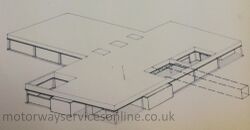Bartlett Review

Between 1965 and 1967 the Bartlett School of Architecture were asked to compare British services with European ones. The aim was not just to comment on how well Britain's new buildings were bedding in, but to try to establish why so many operators were unhappy with what they had built.
Led by Professor Lord Llewelyn-Davies, David Goddard and Bev Nutt, Department Directors of the Joint Unit for Planning Research at University College London, the review concluded that many motorway service areas had taken on an impractical design, which was designed to cater for customers who were having to hang around when all they wanted to do was get back on the road quickly. British service area buildings were often vulnerable to vandalism and theft, because this hadn't been anticipated in their design. Poor design meant that catering and daily maintenance were becoming major ordeals when they didn't need to be.
The study also looked at the location of service areas on different sides of the road, and suggested that the first service area after an urban area would receive more trade (while also adding that the last service area before an urban area received less trade). This may have led to more interest in building service areas near urban areas, which didn't always work out. It also recommended smaller, single-sided service areas, with policies encouraging a wider variety of dining options.
The report examined the internal and external layouts of many service areas in Britain and around Europe. An 'ideal layout' was produced for a major service area, with a single, simple building connected by a long footbridge over the coach park to the other side of the road. The building would have had five entrances, with toilets, transport cafés and night catering near the front, and the larger restaurant at the back. On the 'home' side, the car parks would all be placed close to the road, while on the far side they would be further out.
The terms of reference for the study were:
- to examine the factors which determine the siting, size, layout and design of motorway service areas, and the timing of their introduction
- to review the requirements which influence the design of a motorway service area, and to recommend ways of accommodating these requirements
The School recommended a new "policy of least commitment" going forward, where operators would design buildings that were simple and easy to operate, rather than promising a five star service that they were unable to fulfil. It recommended banning building on bridges, and other changes that the government felt were mostly already in place.
The School's service area research group later provided advice during the Prior Report. One member of the panel remarked in 1974 that none of their main recommendations from the report had been adopted. The government argued that the school "failed to demonstrate the validity of their proposals".
Details of each of their reviews, where available, are listed on the service area page, but the summaries are quite telling:
| Services | Review |
| Frankley | "magnificent" location, "stark and poor" buildings |
| Gordano | "too many portacabins" |
| Heston | "disastrous, cramped, desolate, harsh" |
| Leigh Delamere | "most excellent" |
| Membury | "very noisy, exposed" |
| Michael Wood | "incomprehensible" |
| Rothersthorpe | "austere, stark" |
| Scratchwood | "unsightly" |
| Strensham | "disastrous" |
| Toddington | "a tarmac wasteland, appalling" |
| Watford Gap | "lacking any design quality, showing no environmental concern" |